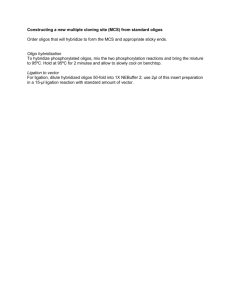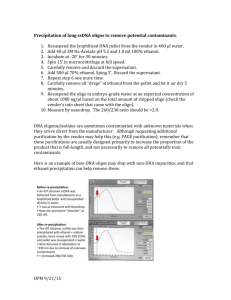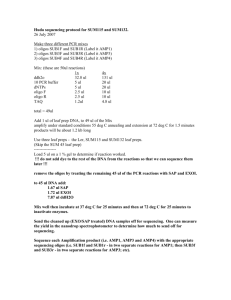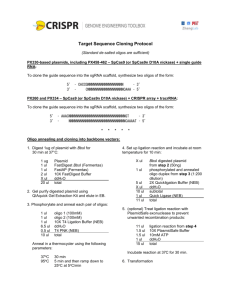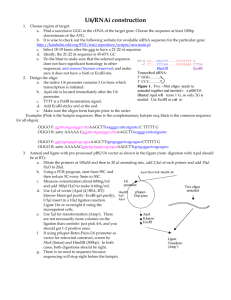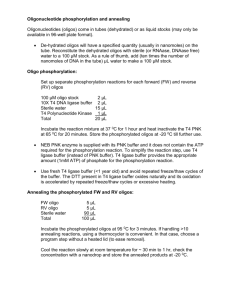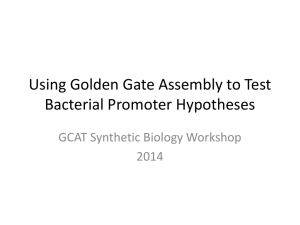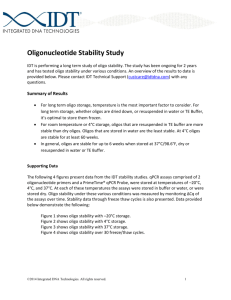The proposal in MS
advertisement
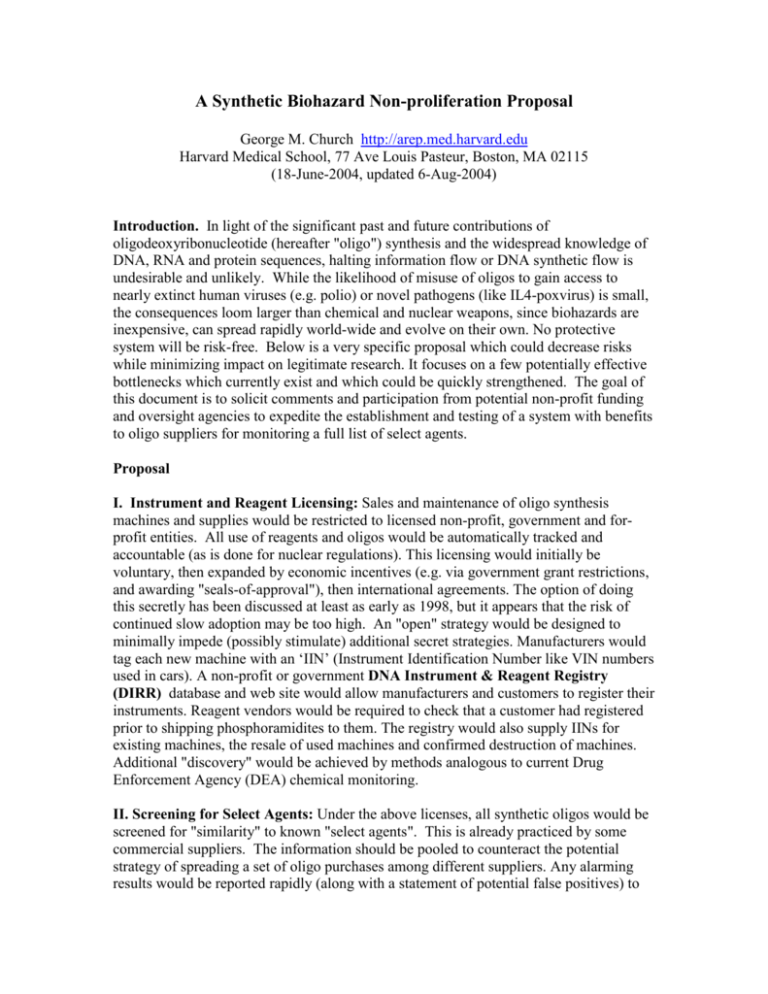
A Synthetic Biohazard Non-proliferation Proposal George M. Church http://arep.med.harvard.edu Harvard Medical School, 77 Ave Louis Pasteur, Boston, MA 02115 (18-June-2004, updated 6-Aug-2004) Introduction. In light of the significant past and future contributions of oligodeoxyribonucleotide (hereafter "oligo") synthesis and the widespread knowledge of DNA, RNA and protein sequences, halting information flow or DNA synthetic flow is undesirable and unlikely. While the likelihood of misuse of oligos to gain access to nearly extinct human viruses (e.g. polio) or novel pathogens (like IL4-poxvirus) is small, the consequences loom larger than chemical and nuclear weapons, since biohazards are inexpensive, can spread rapidly world-wide and evolve on their own. No protective system will be risk-free. Below is a very specific proposal which could decrease risks while minimizing impact on legitimate research. It focuses on a few potentially effective bottlenecks which currently exist and which could be quickly strengthened. The goal of this document is to solicit comments and participation from potential non-profit funding and oversight agencies to expedite the establishment and testing of a system with benefits to oligo suppliers for monitoring a full list of select agents. Proposal I. Instrument and Reagent Licensing: Sales and maintenance of oligo synthesis machines and supplies would be restricted to licensed non-profit, government and forprofit entities. All use of reagents and oligos would be automatically tracked and accountable (as is done for nuclear regulations). This licensing would initially be voluntary, then expanded by economic incentives (e.g. via government grant restrictions, and awarding "seals-of-approval"), then international agreements. The option of doing this secretly has been discussed at least as early as 1998, but it appears that the risk of continued slow adoption may be too high. An "open" strategy would be designed to minimally impede (possibly stimulate) additional secret strategies. Manufacturers would tag each new machine with an ‘IIN’ (Instrument Identification Number like VIN numbers used in cars). A non-profit or government DNA Instrument & Reagent Registry (DIRR) database and web site would allow manufacturers and customers to register their instruments. Reagent vendors would be required to check that a customer had registered prior to shipping phosphoramidites to them. The registry would also supply IINs for existing machines, the resale of used machines and confirmed destruction of machines. Additional "discovery" would be achieved by methods analogous to current Drug Enforcement Agency (DEA) chemical monitoring. II. Screening for Select Agents: Under the above licenses, all synthetic oligos would be screened for "similarity" to known "select agents". This is already practiced by some commercial suppliers. The information should be pooled to counteract the potential strategy of spreading a set of oligo purchases among different suppliers. Any alarming results would be reported rapidly (along with a statement of potential false positives) to appropriate government security agencies, e.g. Dept. Homeland Safety (DHS), Center for Disease Control (CDC), and FBI. The agencies currently responsible for maintaining the select agent lists would consider proposals for adding new sequences from a broad spectrum of biomedical researchers on a timely basis. Changes in the sequences compatible with gene function would be expanded as they are anticipated (e.g. nearly neutral codon or aminoacid changes, degenerate oligos, etc.) Analyzing customer oligo sequences for anything other than biohazards would be strongly discouraged (as it is already). One reading of the current CDC regulations on select agents is that oligos are not subject to those regulations and the Dept. of Commerce doesn’t care about anything less than 200 bases in length. These regulations could be tightened and clarified publicly, while ensuring that oligo companies see a net benefit, not cost and liabilities. One scenario would be to set up a non-profit DNA Agent Clearinghouse (DAC) with NIH, USDA, and/or DARPA funding and CDC, DHS, and FBI oversight. The software (e.g. BlackWatch), installation and testing would be made freely available to the oligo vendors. Any positive matches that are found on site would be sent to the Clearinghouse, with a copy to the site managers. Staff at the Clearinghouse (with security clearance) would evaluate the sequences and make an immediate preliminary assessment. They would also add those sequences to a second system that would look for patterns of activity like related oligos being ordered from multiple vendors. If something significant turns up, the Clearinghouse can contact the vendor and go directly to someone at the FBI, DHS, etc who can initiate appropriate follow up action. The instrument registry above could be coordinated with the Clearinghouse. This approach frees the vendors from a lot of effort and responsibility. Customer data remain confidential unless a match is found. It puts the task of assessing sequence matches and false positives in the hands of experts. The FBI only has to deal with incidents being reported from a single source. They can be confident that any report they get is significant and worthy of their attention. The Clearinghouse could be affiliated with other bioinformatics activities to attract top intellectual input. III. Testing: The system can fail if it is not tested frequently, so a "testing group" can be assigned to submit orders for oligos and/or reagents from each licensed entity at frequent but random times. Both the testing and screening groups should have some form of commercial and/or academic/social reward for improved performance (i.e. lower false positives and negatives). While PCR primers will be harder to detect than whole gene syntheses, they may be less common since their use requires access to the intact select agent. IV. Exemptions: Legitimate uses of oligos for select agents would be pre-approved by relevant CDC permit, Biohazards Safety, grant peer review and other existing agencies. A secure, computer-readable list of allowed target DNA/protein sequences would be prepared for each such end user and transmitted to the screening groups. Testing group submissions would not usually be accompanied by such pre-approval, but would be presubmitted to the government security agencies only to eliminate that type of false positive. No doubt there will be government agencies which are exempt from the entire system. V. Costs: The cost of setting up the non-profit DIRR and DAC could be kept low and responsible administration high by embedding them in existing grant-funded non-profit institutions. The cost of maintenance would be the salaries of the staff, which would include at least a director, legal counsel, a database expert, a web programmer, and a synthetic biologist. The director and biologist could be 50% FTE. For the initial phase of installing the software in the laboratories of over 100 universities, biotech companies and commercial oligo vendors will require training and travel for 4 technicians. Hopefully much of the installation can be done via web downloads, but having the technicians available by phone, email and personal travel should greatly increase community acceptance. Possibly some financial incentives could be provided to the early adopter beta-test sites to pay for lost staff-time while they work with DIRR & DAC staff. Attendees nominated for "Risk committee" at the Synthetic Biology 1.0 meeting (June 10-12, 2004, Cambridge MA): Roger Brent, George Church, Drew Endy, Daniel Fletcher, Jay Keasling, Ken Nesmith, Carl Pabo, George Poste, Paul Rabinow, Pam Silver. Acknowledgments: Working on array DNA synthesizers with Steve Kieffer-Higgins, on "genome engineering" with Andy Link, and on DARPA projects with Tom Knight were crucial in formulating early thoughts on these subjects. Recently these gelled further in writing a white paper for DOE (chaired by Ray Gesteland) and conversations with most of the above "Risk" group. Especially significant are contributions from Tom Knight, John Mulligan, Ron Davis, and Robert Jones. References: CIA, Academy of Sciences "Darker bioweapons future" http://www.fas.org/irp/cia/product/bw1103.pdf Cello J, Paul AV, Wimmer E. Chemical synthesis of poliovirus cDNA: generation of infectious virus in the absence of natural template. Science. 2002;297(5583):1016-8. Church, G.M. and Kieffer-Higgins, S. (1992) WO 92/21079A1 Parallel Sequential Reactor. Hoult M, & Mulligan, J Public Comments on the New Regulation 03-SAR-049 http://www.cdc.gov/od/sap/comments/03sar049.htm Jackson RJ, Ramsay AJ, Christensen CD, Beaton S, Hall DF, Ramshaw IA. Expression of mouse interleukin-4 by a recombinant ectromelia virus suppresses cytolytic lymphocyte responses and overcomes genetic resistance to mousepox. J Virol. 2001 Feb;75(3):1205-10. Jones, J. Craic (2003) Computing LLC. Hazardous Biological Agent Sequence Detection https://biotech.craic.com/blackwatch/index.html http://www.cdc.gov/od/sap/comments/03sar110.pdf Joy, W (2000) Why the future doesn't need us. Wired 8.04. Morgan B and Youderian, P (1977) Doing DNA at home: A recipe for Botulism http://arep.med.harvard.edu/gmc/Real77.pdf Mulligan, J (2003) Bioterror threat from gene synth is immediate, not far off. Genome Technology. https://biotech.craic.com/blackwatch/BlackWatch_GenomeTechnologyLetter.pdf Tian J, Gong H, Sheng N, Zhou X, Gulari E, Gao X, & Church GM (2004) Accurate Multiplex Gene Synthesis from Programmable DNA Chips. http://arep.med.harvard.edu/SBP/ Nature in revision Select agents HHS, USDA, CDC (including 42 C.F.R. Part 73, Federal Register, Vol. 240, No. 67 Dec 13, 2002) http://www.cdc.gov/od/sap/docs/salist.pdf http://www.cdc.gov/od/sap/ NIH Recombinant DNA and Gene Transfer Guidelines: http://www4.od.nih.gov/oba/rac/guidelines/guidelines.html Suppliers of 2-cyano-ethyl N,N-diisopropylchlorophosphoramidite (key precursor): http://www.cmschemicals.com/CMSChemicals/CMSProd.nsf/0/d0e383d8b3f1b24580256c41003bb2 27?OpenDocument http://www.chembuyersguide.com/partners/dalton.html Suppliers of phosphoramidites, CPG, anhydrous solvents (key to oligo synthesis): http://www.glenres.com/ http://egt.horus.be/code/en/page_08.asp?Page=276&smenu=5 Synthesis machines sources: Beckman 1000M $11K grizzlyanalytical.com Biolytic BLP 192 $125K biolytic.com Biosearch 8700, 8750; CyClone $8K-11K Cruachem PS250 $3K MerMade 192 $90K bioautomation.com PE-ABI 3900 $70K; 394,392,391,390Z,3948, Expedite8909 $ 11-25K Polygen 10 $90K www.polygen.de Polyplex Gene Machine $89K genomicsolutions.com TAGC96 $95K tagc.com Commercial oligo suppliers: Illumina Qiagen-Operon OligosEtc Invitrogen IDT MWG illumina.com oligos.qiagen.com oligosetc.com invitrogen.com idtdna.com mwg-biotech.com Examples of Academic oligos suppliers: www.albany.edu/genomics/oligos.html ww2.mcgill.ca/sheldon/oligonucsynthesis.htm msf.ucdavis.edu/oligo.html hms Custom oligo array suppliers: Agilent Febit Metrigen Nimblegen Oxamer Xeotron/Atactic/Invitrogen Combimatrix chem.agilent.com febit.com/geniom metrigen.com nimblegen.com oxamer.com xeotron.com combimatrix.com US Synthetic gene suppliers: Abetal LLC Aldevron AnaGen Technologies Aptagen Bio Applied Technologies Joint BioNexus BioTech Core Blue Heron Biotech Certigen Commonwealth Biotechnologies DNA 2.0 Egea Biosciences GeneMed Synthesis GenScript IDT MCLAB Midland Modular Genetics Molecular Diagnostic Services Picoscript Qiagen SeqWright abetal.com aldevron.com ana-gen.com aptagen.com batj.net genesynthesis.net biotechcore.com blueheronbio.com certigen.com cbi-biotech.com dnatwopointo.com egeabiosciences.com genemedsyn.com genscript.com idtdna.com mclab.com oligos.com modulargenetics.com mds-usa.com picoscript.com qiagen.com seqwright.com Sigma Genosys Retrogen sigma-genosys.com retrogen.com Non US Gene Synthesis Scandinavian Gene Synthesis GeneArt Entelechon Evrogen (Russia) BaseClear (Netherlands) Bio S&T Inc. (Canada) OZEX (Australia) Metabion Medigenomix GMBH BioSpring TWCBiosearch MedProbe AS Genosphere Biotechnologies TechDragon Limited IBA Chemos CZ Microsynth GeneXpress sgsdna.com geneart.de entelechon.de evrogen.com baseclear.com biost.com ozex.biz metabion.com medigenomix.de biospring.de twcbiosearch.com medprobe.com genosphere-biotech.com techdragon.com.hk iba-go.com chemos.cz microsynth.ch genexpress.at
